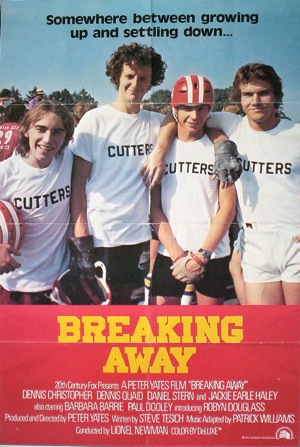Difference between revisions of "Cutter Homoerotics in Breaking Away"
m (Protected "Cutter Homoerotics in Breaking Away" [edit=sysop:move=sysop]) |
|||
| (One intermediate revision by one other user not shown) | |||
| Line 26: | Line 26: | ||
</div> | </div> | ||
| − | [[Category:Stryker]] <comments /> | + | [[Category:Stryker]][[Category:Bloomington]] <comments /> |
Latest revision as of 10:28, 1 May 2010
Breaking Away is a 1979 coming-of-age film that profiles the life of a Bloomington townie kid named David Stoller, a recent high school graduate with no definite plans for the future, who escapes from the doldrums of local life on his bicycle. The film was nominated for an Academy Award for Best Picture (losing to the Meryl Streep/Dustin Hoffman divorce melodrama Kramer vs. Kramer). It is ranked eighth on the American Film Institute list of “100 Most Inspiring Movies of All Time.” The story was loosely modeled on the life of Bloomington local-legend cyclist David Blase.

The film captures the complicated class relationships between the town kids who call themselves “cutters” in honor of the men in their working-class families who cut limestone in the local quarries, and the students who attend IU. David, the protagonist, thinks he might want to go to college, but feels he would betray his class, his family, and his friends if he does not get a skilled job manual labor job. Unfortunately, in 1970s small town America, those kinds of jobs are increasingly had to find. It’s only while cycling that David can evade, for a while, the complex tangle of his conflicting dreams and emotions.
David idolizes the Italian road-racing bicycle team, who symbolize the possibility of a glamorous and exciting life elsewhere. The Italian team is in Bloomington training to compete in the annual Little 500 bicycle race, a real-life Bloomington tradition modeled on the famous Indianapolis 500 automobile race, that raises college scholarship money for local youth. Much to the consternation of his father, David begins emulating his heroes by spouting random phrases of Italian in a fake accent, listening to Rosetti operas, greeting his mother with an ostentatious kisses on each cheek, hugging his father, and—to cut down on wind resistance while cycling—shaving his legs. To David’s father, his son’s imitation of European mannerisms, and his obvious infatuation with a bunch of darkly handsome foreign men, seems effeminate, and possibly gay.
David is not gay, and his crush on a college girl who is clearly out of his league propels the story’s narrative arc, as he pretends to be an Italian exchange student in an ever more desperate and implausible skein of misrepresentatons through which he hopes to win her affections. There are, however, moments of genuine homoeroticism in the film, as when David and his well-muscled cutter friends swim in an abandoned quarry, in various states of undress.
In the 1980s, the Bloomington Gay Alliance sponsored a men’s dance party called “The Quarries” that implicitly references this scene in Breaking Away, and the local traditions on which the film representations were based. The flyer for the gay theme party plays on the eroticizable hierarchies of unequal power that structure the fantasies invoked by the flyer's image—working class/middle class, less educated/more educated, place-bound/mobile; straight/gay. The Quarryland Gay Men’s Chorus, founded in 2003, draws upon the same homoerotic iconography.
Breaking Away is not a "gay movie," but portrays the emotional landscape of Bloomington in the 1970s upon which youthful masculinities navigated their tortuous paths to the future —a landscape in which foreigners seem queer, and wanting to be like them can seem queerer still. In the end, the triumph David experiences in winning the girl, winning the race, and breaking away, with the blessings and support of his friends and family, is a kind of “coming out” into the sort of life he wants to live. But perhaps the queerest aspect of this incredibly straight film is its portrayal of the bonds between a son and a father, a young man and his mother, a cutter and his friends, that are powerful enough to survive a loved one’s decision lead a different sort of life.
Sources
Breaking Away, Directed by Peter Yates (1979; 20th Century Fox: 2009).
The Quarries, flyer, GLBT Student Support Services Office Files.
Navigation | Home | Before Stonewall | Stonewall to AIDS: the 70s |
AIDS and Community Life: the 80s | The Queer Decade: the 90s | Queer Here and Now: 2001-Present
<comments />